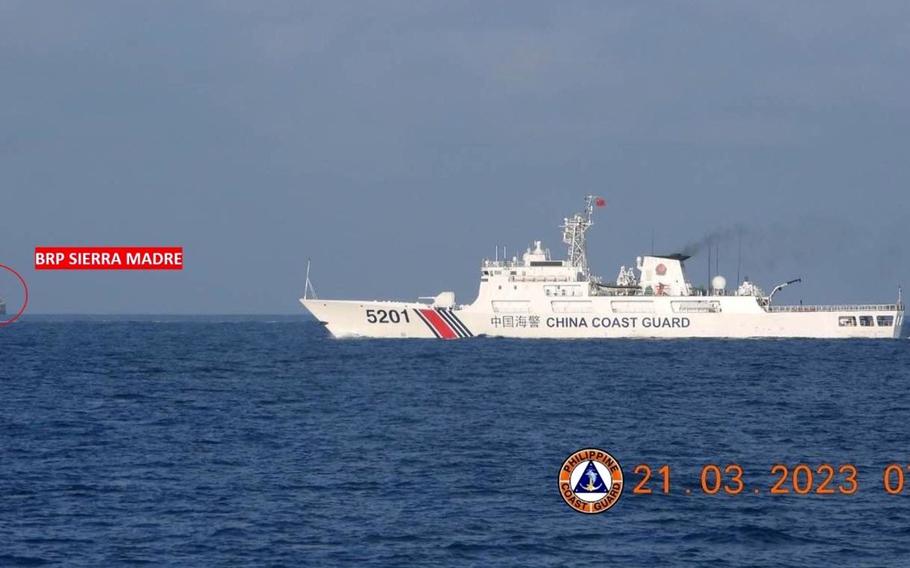
A Chinese coast guard vessels steams near the BRP Sierra Madre, a former U.S. Navy vessel grounded at Second Thomas Shoal in the South China Sea, March 21, 2023. (Philippine coast guard)
The Philippines has resupplied its troops on a grounded warship in disputed South China Sea waters despite an attempted Chinese blockade, the Philippine government announced this week.
Supply boats reached the BRP Sierra Madre, a grounded navy ship that serves as an outpost at Second Thomas Shoal in the Spratly Islands, on Tuesday, the Philippines’ National Task Force for the West Philippine Sea said in a statement that day.
The mission was successful despite efforts by the “China Coast Guard and Chinese Maritime Militia vessels to block, harass, and interfere,” the statement said.
The Philippine coast guard invited a small group of journalists, including two from The Associated Press, to join its ships that secured the supply boats as part of a new strategy aimed at exposing China’s increasingly aggressive actions in the South China Sea, which Beijing claims virtually in its entirety.
As a U.S. Navy plane circled overhead, one Chinese coast guard ship came as close as 50 yards as it crossed the bow of Cabra to block the Philippine coast guard ship, which maneuvered fast to avoid a collision, said a coast guard officer onboard the Cabra who could not be named because of official policy.
The Cabra and the Sindangan were surrounded by four Chinese coast guard ships and four suspected militia vessels and forced to stop as the other two Philippine boats delivered supplies to the Filipino forces at Second Thomas Shoal, more than 4 miles away.
All the Philippine vessels sailed away without further incident after the supplies and a fresh crew of Filipino sailors were delivered to the military outpost on a long-marooned Philippine navy ship at the shoal.
It was not immediately clear why the U.S. Navy deployed the surveillance plane that flew for more than three hours overhead as the Chinese ships blocked and shadowed the Philippine vessels off Second Thomas Shoal. When asked about the deployment of the Navy plane, U.S. Embassy spokesperson Kanishka Gangopadhyay in Manila said he could not provide specifics. "What I can say is that all of our military activities in the Philippines are conducted in full coordination with our Philippine allies," he said.
Filipino security officials have said they've received intelligence information and surveillance images taken in the disputed waters from their American and other foreign counterparts in the past as part of security cooperation.
The United States lays no claim to the South China Sea but has declared that freedom of navigation and flight, as well as peacefully resolving disputes, are in its national interest.
Two supply boats were supported by the Philippine coast guard’s BRP Sindangan and BRP Cabra during the mission. Philippine navy warships were on standby, the statement said.
The dispute over the shoal has reached a tipping point, according to Krista Wiegand, a professor of national security at the University of Tennessee who spoke Tuesday at an online forum organized by Pacific Forum, a think tank in Hawaii.
“China’s military is being aggressive,” she said of its actions around the shoal, which included firing a water cannon on Aug. 5 to block a boat attempting to deliver supplies to the Sierra Madre. “I’m not sure what more they could do except live fire.”
The Philippines’ grand strategy involves challenging China, according to Renato Cruz De Castro, an international studies professor at De La Salle University, Manila, who also spoke during the forum.
“A great power is basically undermining our border,” he said.
China has occupied disputed features in the South China Sea and built military facilities on some of them in the past decade. It appears to be building an airstrip in the Paracel Islands in the sea, territory also claimed by Taiwan and Vietnam, according to The Associated Press on Friday.
The Philippines is pouring money into defense modernization and President Ferdinand Marcos Jr. has repeatedly told troops to turn their attention to external threats, De Castro said.
Expansion of a base-sharing agreement with the U.S. is part of the effort, he said, noting that three shared bases in northern Luzon aren’t designed to support humanitarian assistance.
“They are only a couple of hundred miles from Taiwan … basically pointing towards Taiwan,” he said.
The Philippines is planning for asymmetric warfare, not just in a South China Sea conflict but in case war breaks out over Taiwan, De Castro said.
“There’s no way we could engage China head on,” he said.
China unfairly paints the Philippines’ actions as being coordinated by the U.S., De Castro said.
“We have to impress on the Chinese and the Filipino people that we are doing it for our national interest,” he said. “It’s a matter of self-respect.”
The U.S. government has become much clearer in indicating its willingness to abide by the terms of the 1951 Mutual Defense Treaty, which encompasses Philippine vessels and outposts in the South China sea, said Raymond Powell, project lead at the Gordian Knot Center for National Security Innovation in Stanford, Calif.
“That’s why China is not directly engaging at the Sierra Madre, which is still considered to be an active-duty naval vessel,” he said during the online forum.
The Associated Press contributed to this report.